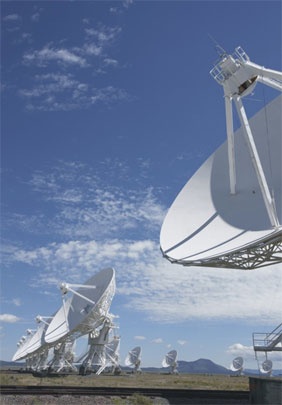NRAO eNews
Volume 3, Issue 11 • November 5, 2010
Upcoming Events
 NRAO Town Hall - 217th AAS Meeting
NRAO Town Hall - 217th AAS Meeting
January 11, 2011 | 6:30 PM | Seattle, WA
 Early Science with the EVLA - Special Session - 217th AAS Meeting
Early Science with the EVLA - Special Session - 217th AAS Meeting
January 12, 2011 | 10:00 AM | Seattle, WA
 Observing with ALMA - Special Session- 217th AAS Meeting
Observing with ALMA - Special Session- 217th AAS Meeting
January 12, 2011 | 2:00 PM | Seattle, WA
 ALMA: Extending the Limits of Astrophysical Spectroscopy
ALMA: Extending the Limits of Astrophysical Spectroscopy
January 15–17, 2011 | Victoria, British Columbia
 Building on New Worlds, New Horizons
Building on New Worlds, New Horizons
March 7–10, 2011 | Santa Fe, NM
ALMA Construction Status
Al Wootten
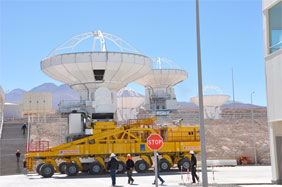
Figure 1: Antenna DV01 being moved to a position adjacent to antenna DV09 (right foreground). (Background) Antennas PM04 (left) and PM01 (right) await their turns in the array.
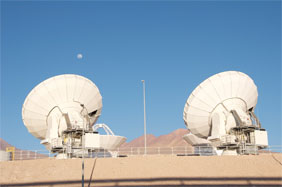
Figure 2: Antennas DV09 (left) and DV01 (right) were successfully joined in the reconstituted OSF Interferometer by members of the AIV team during the month. In the background stand antennas PM04 (left) and PM01 (right).
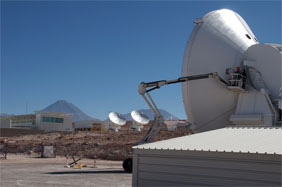
Figure 3: The first European antenna (far right) has undergone its initial optical pointing and holographic tests. In the background, the two elements of the OSF interferometer undergo tests. The OSF complex is on the left; the 19,400 foot elevation stratovolcano Licancabur is in the background.
With eight antennas at the 16,500-foot elevation Array Operations Site (AOS), the next two antennas have remained at the 10,000-foot Operations Support Facility (OSF). Two Vertex antennas, DV01 and DV09, have been united in the OSF interferometer (OSFI). DV01 had seen service at the AOS, where it participated in first fringes, first closure phase, and first amplitude closure before returning to the lower elevation for updating. After testing the antenna was moved into place next to DV09 in preparation for reconstruction of the two-element interferometer. DV01 is the most connected of ALMA antennas, having been interferometrically partnered with more antennas than any other. Antennas pass through the OSFI as part of their shakedown on the way to the main array at the AOS. The OSFI also serves to test ALMA software before it is deployed on the main AOS array.
Two newly delivered antennas have been accepted into the OSFI waiting line. PM01, the third of the Mitsubishi 12m antennas, is being outfitted with ALMA equipment in preparation for its pointing and holography tests, which lead to radiometric testing before the antenna graduates into the OSFI. The tenth Vertex antenna, DV10, was also accepted and moved from the contractor assembly area to a foundation at the OSF where its outfitting will soon begin. Meanwhile, in the construction yard of the European antenna contractor, AEM, the first of those antennas has begun its optical pointing tests and panel setting through holography.
Thirteen 12m antennas have been accepted for outfitting by the ALMA teams, a quarter of the total complement of antennas in the original 50-antenna scope of the project and roughly a quarter of the final 54 antenna total of 12m antennas. One of the dozen 7m antennas is undergoing final testing in the Mitsubishi camp. Elsewhere on the site are the parts for twelve additional 12m antennas, and four 7m antennas.
Multiple readiness reviews have been conducted over the past month to assess the readiness of various parts of the observatory for Early Science, slated to begin in 2011, including Commissioning and Science Verification, Science Operations Readiness, and the Annual ALMA External Review. The ALMA Science Advisory Committee also met during the past month in the new Santiago offices. Though the final review reports are not yet in, all reviewers mentioned that the project had made great progress and foresaw that the observatory should indeed be prepared for beginning Early Science in 2011. Further reviews will occur in early November, culminating in the mid-November meeting of the ALMA Board, and the decision on the timing of the Call for Early Science, expected 22 November.
In preparation for Early Science, several North American ALMA Science Center (NAASC) members have worked on the Commissioning and Science Verification Team in Chile. Crystal Brogan, Ed Fomalont, Todd Hunter, Tony Remijan, Kartik Sheth, and Al Wootten have each spent a number of ‘turnos’ (eight-day shifts) at the OSF in northern Chile. Among the focus areas for this fall has been the use of Early Science observing modes. For this, programs of sets of ALMA Schedule Blocks that contain calibrator and science verification targets are executed on the array and reduced to ensure that the quality of the data obtained is good.
Examples of these projects include:
- NGC 253 CO lines now observed in all four ALMA bands,
- observations of Jovian satellites and evolved star masers at 450 microns (the only currently used receiver which operates double sideband),
- absorption line objects,
- spectral surveys, and
- multiple objects per calibrator set.
Examples will be drawn from these astronimical validation projects that can be used in community tutorials as demonstrations of ALMA Early Science capabilities.
This Month @ the NAASC
Anthony Remijan
Scott Schnee contributing
The North American ALMA Science Center (NAASC) is the interface for the North American scientific community with ALMA. Located at the NRAO headquarters in Charlottesville, Virginia, and partnered with the HIA in Victoria, Canada, and the ASIAA in Taiwan, the NAASC is dedicated to providing various services, programs and applications that can be used by the community to prepare and propose for ALMA time, and to reduce and analyze their ALMA data. In addition, the NAASC provides many more user services including:
- Organizing ALMA meetings/workshops
- Visiting institutions to give presentations on ALMA
- Supporting Commissioning & Science Verification efforts at the Joint ALMA Observatory
- Supporting the community in the preparation of their ALMA proposals
- providing current information on ALMA observing modes and capabilities
- supporting community use of the ALMA Observing Tool
- responding to queries though the helpdesk
- validating observation scripts (termed "schedule blocks")
- Providing post-observation user support
- responding to helpdesk queries
- supporting user visits to NAASC for data reduction)
- Maintaining ALMA websites, proposal guides, and data reduction "cookbooks"
More information about the NAASC and our services.
ALMA Tutorials and Community Days
With the anticipated deadline for the submission of Early Science proposals with ALMA in the first part of 2011, the NAASC will host or sponsor a series of events over the next few months which are designed to familiarize the community with: (a) the Early Science capabilities of ALMA, (b) mm/submm interferometric observing techniques, and (c) the tools required to design ALMA observing programs and submit proposals. These events will include 2-day workshops at the NRAO in Charlottesville, 1-2 day ALMA Community Days hosted by other institutions across North America, and sessions associated with upcoming conferences.
The first of these events will be an "Observing with ALMA" Special Session, held at the winter American Astronomical Society meeting in Seattle on Wednesday, 12 January 2011. Short hands-on tutorials for 2-3 individuals with the ALMA Observing Tool will also be available by sign-up at the NRAO booth. An ALMA Software Tutorial will be held in Victoria on Tuesday 18 January 2011, following the workshop "ALMA: Extending the Limits of Astrophysical Spectroscopy".
The first of the 2-day workshops in Charlottesville is planned for February 2011; dates and registration details will be announced shortly on the NRAO astronomer homepage.
If your institution is interested in the possibility of hosting an ALMA Community Days event in your area, with support from the NAASC, please contact Kartik Sheth (ksheth@nrao.edu) at the NAASC for more information. More details about the planning for these events will be provided in the next edition of the NRAO eNews.
We hope to see everyone interested in using ALMA at one of these events.
Meet the NAASC
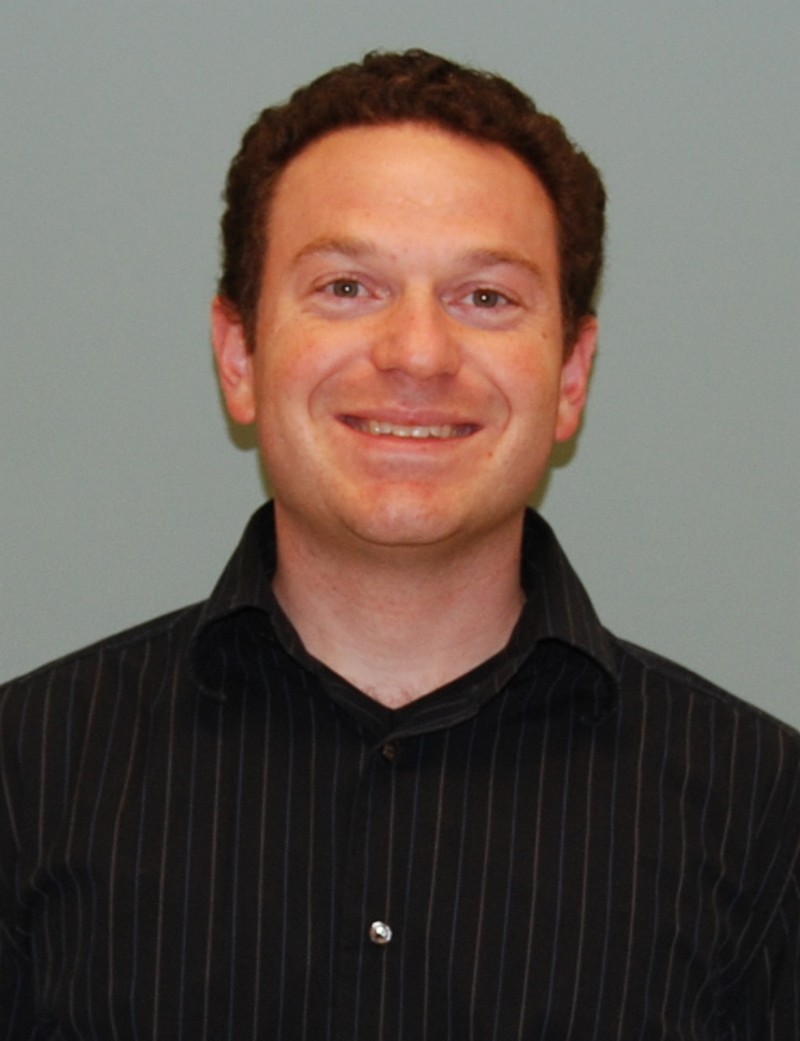 Given the amount of support necessary for the community, our user support team is active and growing. In this section of the "This Month @ the NAASC", we will introduce you to the support scientists and postdocs and their various fields of research they are actively engaged. This month we introduce Scott Schnee, who joined the NAASC on October 1. Scott is an assistant scientist at the NRAO, where he works in the NAASC providing user support for ALMA. Prior to his position at NRAO, he was a research officer (Plaskett Fellow) at the HIA from September 2009 until September 2010. He was previously a CARMA Fellow at Caltech , where his postdoctoral advisors were Anneila Sargent and John Carpenter. He received his degree from Harvard University in the astronomy department , working with Alyssa Goodman. Scott is interested in the properties of the interstellar medium, such as temperature, density and kinematics. He also studies the formation of stars in nearby molecular clouds, in particular the gas, dust and dynamics in starless cores. Finally, Scott works on the chemistry in cold and dense cores and the properties of dust grains in cores and molecular clouds. Read more about Scott and his research interests.
Given the amount of support necessary for the community, our user support team is active and growing. In this section of the "This Month @ the NAASC", we will introduce you to the support scientists and postdocs and their various fields of research they are actively engaged. This month we introduce Scott Schnee, who joined the NAASC on October 1. Scott is an assistant scientist at the NRAO, where he works in the NAASC providing user support for ALMA. Prior to his position at NRAO, he was a research officer (Plaskett Fellow) at the HIA from September 2009 until September 2010. He was previously a CARMA Fellow at Caltech , where his postdoctoral advisors were Anneila Sargent and John Carpenter. He received his degree from Harvard University in the astronomy department , working with Alyssa Goodman. Scott is interested in the properties of the interstellar medium, such as temperature, density and kinematics. He also studies the formation of stars in nearby molecular clouds, in particular the gas, dust and dynamics in starless cores. Finally, Scott works on the chemistry in cold and dense cores and the properties of dust grains in cores and molecular clouds. Read more about Scott and his research interests.
Did you know?
Did you know that version 3.1 of CASA will be released in November? For more information about the changes between versions 3.0 and 3.1 and how to obtain your own version of CASA for reducing your own data, visit casa.nrao.edu. Already have CASA but not quite sure where to get started reducing your data? Try CASA Guides! To review annotated scripts on how to get started reducing data from interferometers around the world and on the flexibility and function of CASA, visit casaguides.nrao.edu.
Expanded Very Large Array Status
Chris Langley, Joseph McMullin, Rick Perley, Gustaaf Van Moorsel, and Steve Durand
The last of the VLA antennas has been converted to the EVLA design and as a result, for the first time since 2005, antenna overhauls have returned to a normal operations maintenance cycle. Although the major antenna retrofits are now complete, a cryogenic system expansion to four compressors continues. This upgrade is necessary to cool EVLA compliant X-band receivers, and it will allow for larger and improved polarizers. This additional compressor ideally will reduce the amount of maintenance required for the cryogenics as a whole. Work will occur during regular antenna overhauls over the remainder of EVLA construction, with minimum exceptions. The degraded azimuth gears on antennas 6 and 7 have been replaced.
Prototype 3-bit 4-Gs/s sampler boards have been installed in four antennas for the purpose of verifying functionality prior to production procurement. Testing is ongoing to determine the source of an excess amount of noise in the 3-bit path. Thus far, tests are inconclusive as to whether the noise is originating from within the sampler assembly, the 3-bit sampler chip, or elsewhere in the system. After characterizing the prototype samplers in the field, tests are continuing predominantly in the lab. A schedule delay on the order of 6 months for 3-bit sampler deployment is likely.
The production and installation of the EVLA-compliant C-band (4-8 GHz), K-band (18-26.5 GHz), Ka-band (26-40 GHz), and Q-band (40-50 GHz) receiver sets are complete or nearing completion. L-Band (1-2 GHz), S-Band (2-4 GHz), X-band (8-12 GHz), and Ku-band (12-15 GHz) receiver production is continuing at the predicted rate. As of this date, the number of available, completed EVLA receivers is: 9 (L), 11 (S), 27 (C), 1 (X), 5 (Ku), 27 (K), 25 (Ka), 27 (Q). There are a total of 27 L- and X-band receivers available, including the interim L-band receivers using VLA-style polarizers, and the old VLA X-band receivers.
Hardware testing of WIDAR assemblies, a precursor to acceptance of the full WIDAR correlator from the National Research Council–Canada, has begun. Hardware testing will verify the successful integration and quality of all correlator components. The complete WIDAR acceptance plan, which will verify the functionality of advanced software and firmware, is being drafted. Final acceptance of the correlator is scheduled for 2012.
Simultaneous with the construction activities, commissioning and science observing are also ongoing. Commissioning work is focused on expanding the existing hardware and software capabilities while improving the technical guidance and options for the community. Updates to capabilities are noted in the EVLA science observing pages.
A number of “knowledgebase” articles specific to EVLA observing have been added to the NRAO Helpdesk. This should alert Helpdesk users to potential answers to their questions as the queries are being entered.
In September, the first 74 MHz (historically called 4-band) observations were made with the new electronics systems and WIDAR correlator. The tests were successful, and these receivers will be deployed by mid-2011 and made available to the community for a special 74 MHz observing campaign at the end of the B-configuration, through BnA, and the beginning of A-configuration (See the updated Observing Status Summary).
The science observing continues through the paired modes of Open Shared Risk Observing (OSRO) and Resident Shared Risk Observing programs. The D-configuration concluded 12 September 2010, having achieved ~ 1600 hours of science observing, which is ~ 30% of the science observing time for 1 Mar – 12 Sep. The array moved to DnC-configuration on 15 September and to C configuration on 12 October.
In January 2011, the next EVLA Call for Proposals will go out on the new NRAO semester-based proposal system (See the 1 September 2010 e-News for more information).
2011 NRAO Summer Student Research Assistantships
Jeff Mangum
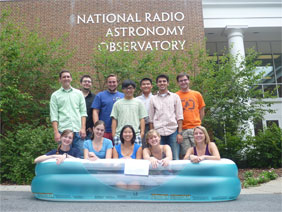
The participants in the 2010 NRAO Summer Student Research Assistantship program based in Charlottesville, VA.
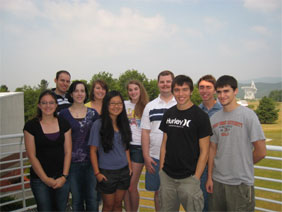
The participants in the 2010 NRAO Summer Student Research Assistantship program based in Green Bank, WV.
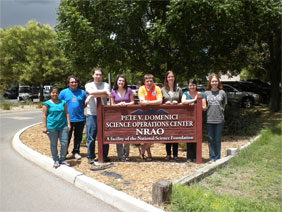
The participants in the 2010 NRAO Summer Student Research Assistantship program based in Socorro, NM.
NRAO is now accepting applications for the 2011 NRAO Summer Student Research Assistantships program. Each summer student conducts research under the supervision of an NRAO staff member at one of the NRAO sites, on a project in the supervisor's area of expertise. The project may involve any aspect of astronomy, including original research, instrumentation, telescope design, or astronomical software development. Examples of past summer student research projects are available on the Summer Student website.
Supervisors choose their own student candidates from the received applications, and the site to which a summer student is assigned depends on the location of the NRAO supervisor who chose them. Students are encouraged to review the NRAO staff web pages to learn more about the types of research being conducted at the NRAO. On their application, students may request to work with a specific staff member, to work on a specific scientific topic, or to work at a specific site.
The program runs 10-12 weeks each summer, from early June through early August. At the end of the summer, participants present their research results in a student seminar and submit a written report. These projects often result in publications in scientific journals. Financial support is available for students to present their summer research at an American Astronomical Society meeting, generally at the winter meeting following their appointment.
Besides their research, students take part in other activities, including multiple social events and excursions, and an extensive lecture series that covers various aspects of radio astronomy and astronomical research. Students also collaborate on their own observational projects using the VLA, VLBA, and/or GBT.
There are three types of Summer Student programs available at the NRAO.
The NRAO Research Experiences for Undergraduates (REU) program is for undergraduates who are citizens or permanent residents of the United States or its possessions, and is funded by the National Science Foundation (NSF) Research Experiences for Undergraduates (REU) program.
The NRAO Undergraduate Summer Student Research Assistantship program is for undergraduate students or graduating college seniors who are U.S. citizens, are from an accredited U.S. Undergraduate Program, or are otherwise eligible to work in the U.S. This program primarily supports students or research projects that do not meet the REU guidelines, such as graduating college seniors, some foreign undergraduate students, or projects involving pure engineering or computer programming.
The NRAO Graduate Summer Student Research Assistantship program is for graduate students who are citizens or permanent residents of the United States or its possessions, enrolled in an accredited U.S. Graduate Program, or otherwise eligible to work in the U.S.
The stipends for the 2011 Summer Student Program will be $610 per week for undergraduates and graduating seniors, and $652 per week for graduate students. These stipends include an allowance for housing, since housing is not provided.
Students who are interested in Astronomy and have a background in Astronomy, Physics, Engineering, Computer Science, and/or Math are preferred. The same online application form and process is used for all three programs. Required application materials include an on-line application form (including a statement of interest), transcripts, and three letters of recommendation. The deadline for receipt of application materials is Tuesday, 1 February 2011.
Funding Approved for an Advanced Multibeam Spectrometer for the GBT
D. Anish Roshi, Karen O'Neil, John Ford

Figure 1: Srikanth Bussa, an intern at NRAO-Green Bank is characterizing the analog-to-digital converters that will be used for the Advanced Multibeam Spectrometer. Srikanth is a M.S Electrical and Computer Engineering graduate student from the University of Akron, OH.
The National Science Foundation Advanced Technologies and Instrumentation (NSF-ATI) program has approved funding for a new GBT spectrometer backend. This spectrometer will be built by the CICADA collaboration -- a collaboration between NRAO and the Center for Astronomy Signal Processing and Electronics Research (CASPER) at the University of California–Berkeley.
The new backend will replace capabilities of the existing spectrometers and will support data processing from focal plane array systems. Thus the capabilities of the spectrometer will be synergetic with the multi-pixel camera development program for the Green Bank Telescope (GBT). In the present design, the spectrometer will be capable of processing up to 1.25 GHz bandwidth from 8 dual polarized beams or a bandwidth up to 10 GHz from a dual polarized beam. The spectrometer will vastly enhance GBT capabilities and enable new science with the GBT: searches for organic molecules in the interstellar medium; determination of the fundamental constants of our evolving Universe; further investigations of the dynamics in star-forming regions; and surveys for pulsars in the extreme gravitational environment of the Galactic Center.
Recent Press Releases
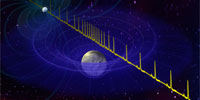 Astronomers Discover Most Massive Neutron Star Yet Known
Astronomers Discover Most Massive Neutron Star Yet Known
Astronomers using the National Science Foundation's Green Bank Telescope (GBT) have discovered the most massive neutron star yet found, a discovery with strong and wide-ranging impacts across several fields of physics and astrophysics.
"This neutron star is twice as massive as our Sun. This is surprising, and that much mass means that several theoretical models for the internal composition of neutron stars now are ruled out," said Paul Demorest, of the National Radio Astronomy Observatory (NRAO). "This mass measurement also has implications for our understanding of all matter at extremely high densities and many details of nuclear physics," he added. Read more...
From the Archives: CDL Machine Shop
Ellen Bouton

About this month's photograph: The unique work and cutting edge technology at NRAO Central Development Laboratory draws visitors from around the world. In this photo, dated 19 October 1989, NRAO's Matt Dillon (red shirt) and Garnett Taylor (striped shirt) show off the Machine Shop at the Ivy Road facility to visitors from Observatoire de Bordeaux, R. Lauqué and F. Chauvet.
From the Archives is an ongoing series illustrating NRAO and U.S. radio astronomy history via images selected from our collections of individuals' and institutional papers. If readers have images they believe would be of interest to the Archives, please contact Ellen Bouton, ebouton@nrao.edu.
Career Opportunities
New Postings
Web Application/Database Developer: The National Radio Astronomy Observatory in Charlottesville, VA is seeking a Web Application/Database Developer. The successful candidate will be responsible for developing, testing, implementing, and supporting the public outreach website of the NRAO. He/she will work as part of a team of content and design/graphics specialists to develop a science and technology web site that includes web-based interactives, video products, and mobile device applications. The Web Application/Database Developer will also administer content management system and define and codify technical requirements for products specified by the team.
NRAO Postdoc: The National Radio Astronomy Observatory in Charlottesville, VA is seeking a NRAO Postdoc (NAASC Postdoctoral Fellow). This position is aimed primarily at independent research, with an emphasis on developing ALMA expertise and assisting the NAASC scientific staff in the support of ALMA users. ALMA-related activities may include: exercising ALMA end-user software from a scientific perspective, including the Observing Proposal and Submission tool, and the ALMA data reduction and analysis package CASA (Common Astronomy Software Applications); helping to develop ALMA tutorials and other user-outreach materials; and assisting visiting scientists with observation preparation and data reduction.
NRAO Postdoc: The National Radio Astronomy Observatory invites applications for the NRAO Postdoc (ALMA Commissioning Postdoc) position located in Santiago, Chile. The role of the ALMA Postdoctoral Fellow will be to assist the ALMA Commissioning Team in planning and executing the scientific commissioning of ALMA. As a member of the commissioning team, the successful applicant will work on preparing specific test procedures and trouble-shooting them, carrying out measurements, processing the data and producing reports. Assignments may include tasks such as measuring the properties of individual antennas, testing and calibrating the various interferometric observing modes, and moving on to verifying the quality of the scientific data that ALMA produces.

 Zoom
Zoom